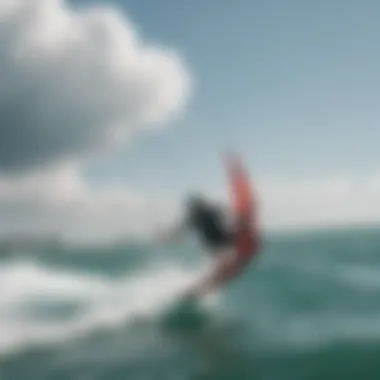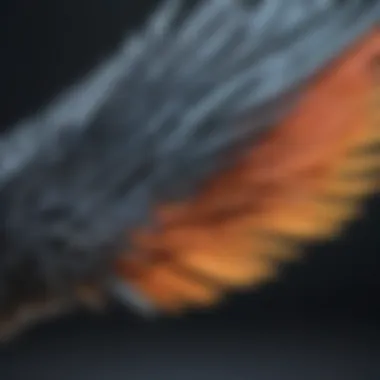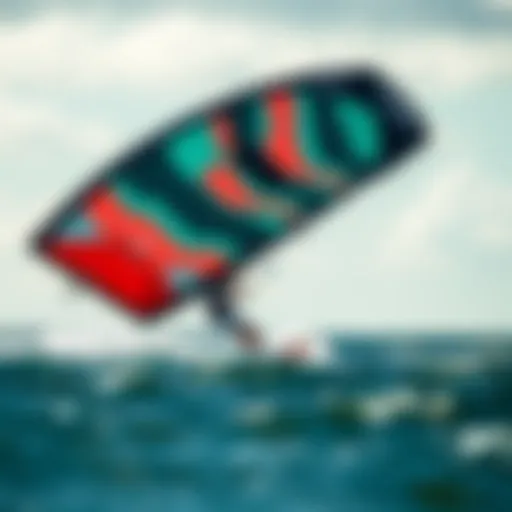Exploring the Duotone Wing: A Comprehensive Examination


Intro
Kiteboarding has seen numerous advancements over the years, but few have made as significant an impact as the duotone wing. This innovation not only enhances rider performance, but also elevates the overall experience on the water. With its unique design and functionality, the duotone wing has quickly become a cornerstone for both beginners and seasoned riders alike. As we navigate the intricacies of this essential gear, we'll highlight standout points, practical insights, and its relevance in the kiteboarding community.
Gear Selection
Selecting the right gear can be likened to finding the perfect dance partner—each element needs to harmonize for an enjoyable experience on the water. The duotone wing's design plays a major role in how it interacts with other components of your kiteboarding setup.
Types of Kites
When considering the right type of kite, it is essential to understand the different styles that complement the duotone wing. The common varieties include:
- Foil Kites: Known for their efficiency in lower winds, these kites can provide ample lift and stability, making them a solid choice.
- LEI (Leading Edge Inflatable) Kites: These kites tend to be versatile, allowing for dynamic maneuvering and robust performance in various conditions.
Each kite brings its own flavor to the experience, thus it’s prudent to assess where you’ll be riding and in what conditions before securing your choice.
Choosing the Right Board
Much like a skateboard, the board you use should fit your personal style and riding objectives. Consider these points:
- Board Size: A larger board gives you greater stability, which is often preferable for beginners. Conversely, experienced riders may favor a smaller board for enhanced agility.
- Board Type: Some boards are optimized for speed while others favor tricks. Pinpointing the type of riding you enjoy will guide your decision.
Your board should act as an extension of your body, allowing for fluid transitions between maneuvers whilst maintaining comfort.
Skill Development
Once geared up, the next step is to hone your skills. Developing confidence and proficiency on the duotone wing can open doors to new levels of kiteboarding enjoyment.
Essential Techniques
Mastering some basic techniques is pivotal. Start with:
- Body Positioning: Keep your body aligned with the wing, as this ensures control during turns.
- Speed Control: Learn to gauge when to pump the wing for lift and when to soften your approach in turbulent waters.
- Smooth Transitions: Practice shifting your weight smoothly between edges to maintain balance.
Progression Tips
Growth takes time, and kiteboarding is no different. Consider these tips to progress effectively:
- Set Goals: Break down your learning objectives into achievable milestones. It could be landing your first jump or mastering a new trick.
- Seek Feedback: Don’t shy away from asking fellow kiteboarders for their insights or tips on improving your technique.
Remember, every pro was once a beginner. Allow your skills to develop at your own pace while enjoying the journey.
"Kiteboarding is a dance with the wind; every move is a new step.”
Through careful gear selection and dedicated practice, riders of all levels can deepen their appreciation for this exhilarating sport. Stay tuned as we unravel more facets of the duotone wing's influence.
The Evolution of Kiteboarding Gear
The world of kiteboarding has undergone a significant transformation since its inception. Understanding the evolution of kiteboarding gear, especially the Duotone Wing, is crucial for several reasons. It sheds light on how advances in design and technology have led to enhanced performance and safety, making the sport more accessible to a wider audience. As kiteboarding progresses, each change in gear reflects the needs and insights of its diverse community of riders—from casual enthusiasts to seasoned pros.
Significantly, the evolution has also encompassed an important aspect: sustainability. Manufacturers and riders alike are beginning to recognize the environmental impact of kiteboarding equipment. This realization is leading to a shift in how gear is produced, used, and even discarded.
In this rich landscape of innovation, some key elements stand out, including material advancements, design optimizations, and the integration of technology. All of these developments converge to ultimately enhance the overall kiteboarding experience for everyone involved.
A Historical Perspective
Kiteboarding, now recognized as a thrilling watersport, traces its roots back to the 13th century with the use of kites for transportation and warfare. However, the modern version as we know it began to take shape in the late 20th century. The first kiteboards, which focused on harnessing wind power, made their appearance in the early 1990s. With simple designs and basic control, riders scratched the surface of what could potentially be achieved on water with a little more innovation.
Through the late '90s and early 2000s, the sport gained traction, bringing with it a surge in interest and participation. Enthusiasts, event organizers, and industry players began to experiment with various materials and constructions, paving the way for more sophisticated designs. Notably, the introduction of inflatable kites marked a turning point, facilitating greater safety and stability in flight.
As we pushed into the 2010s, the winds of change continued to blow, bringing forth the need for improved control and versatility. This led to a shift towards wings that could offer both flexibility and performance, culminating in the advent of the Duotone Wing.
Key Innovations Leading to the Duotone Wing


The path to developing the Duotone Wing is paved with numerous innovations that have solidified its place in the kiteboarding realm. Some breakthroughs that are crucial in this journey include:
- Material Composition: The use of lightweight, high-strength materials such as ripstop nylon and polyester has drastically improved durability and performance while reducing weight.
- Wing Shape and Size: Over the years, designers have explored various wing shapes and sizes, optimizing them for different riding styles. The Duotone Wing, for instance, balances lift and control, which is essential whether one is freestyle riding or tackling waves.
- Control Systems: The development of more intuitive and responsive control systems has enhanced the rider’s experience. These innovations allow for fine-tuning adjustments, enabling riders to adapt to different wind conditions with ease.
- Portability Improvements: Innovations have also focused on making the wings easy to transport and store, catering to the lifestyle of modern kiteboarders who relish chasing the next big swell.
As kiteboarding gear continues to evolve, it not only reflects advancements in technology but also a deeper understanding of performance and rider needs. The Duotone Wing signifies this evolution, embodying the peaks of craftsmanship and advanced materials that define the next generation of kiteboarding equipment.
Understanding the Duotone Wing
The Duotone Wing represents a significant leap in the kiteboarding landscape, merging cutting-edge technology with user-centric design. Understanding the intricacies of the Duotone Wing can greatly enhance a rider's experience on the water, allowing for a deeper appreciation of its capabilities and features. This section illustrates the foundational elements, mechanical functionality, overall styling, and advantages that these wings provide for both novice and experienced riders.
Design Features
Material Composition
The material composition of the Duotone Wing plays a pivotal role in its performance and durability. Crafted from high-quality ripstop fabrics, these wings are designed to withstand the rigors of various weather conditions while maintaining structural integrity. The use of lightweight yet durable materials ensures that the wing can catch the wind effectively.
For example, the use of Dacron in the leading edges contributes to a balanced weight distribution, making it easier for riders to handle the wing. This characteristic makes it a popular choice among kiteboarders who are looking for reliability and performance in their gear. However, while the materials enhance overall performance, they can be pricier than standard options, which may be a factor for cost-conscious riders.
Wing Shape and Size
The shape and size of the Duotone Wing are not merely aesthetic; they are engineered for performance. With a range of sizes available, riders can select a wing that best fits their skill level and intended use. A larger wing offers more surface area for lift, making it easier to get going in lighter winds, while smaller sizes provide agility and speed in stronger winds.
Its unique design features, such as a slightly curved outline, facilitate a seamless flow of air, enhancing lift and control. This characteristic is especially beneficial to advanced riders looking for precision and responsiveness in their maneuvers. However, choosing the right size can be tricky; a rider unfamiliar with their capabilities might select a wing that either overpowers them or feels sluggish, underscoring the need for careful consideration in selection.
Storage and Portability
One of the standout benefits of the Duotone Wing is its emphasis on portability. Designed with the rider in mind, these wings can be rolled up into compact sizes, making them easy to transport. The strategic use of packs designed for wings ensures safe storage and protection against wear and tear during travel.
The addition of lightweight materials aids in this portability, allowing riders to carry their wings without feeling bogged down. Nevertheless, potential drawbacks include the need for more thorough care. Riders must be diligent about packing their wings properly to avoid damaging any components, adding an extra layer of responsibility.
Mechanical Functionality
Lift Generation
Lift generation is at the heart of what makes the Duotone Wing a true marvel in kiteboarding. The shape of the wing, combined with the angle at which it can be positioned, allows for optimal lift in various wind conditions. Riders can achieve lift at lower wind speeds compared to traditional kites, giving them a distinct advantage.
A notable aspect of this lift generation is the ability to adapt to different styles of riding. Whether someone is cruising calmly or seeking to execute high jumps, the wing provides the necessary support without compromising performance. However, extreme wind conditions may challenge its lift capabilities, necessitating an experienced approach to flying it.
Stability and Control
Stability and control are crucial factors for a smooth riding experience. The Duotone Wing is engineered to minimize turbulence and promote a balanced flight path. Riders can feel secure, knowing that a well-designed wing can respond accurately to their inputs, allowing for greater freedom in their movements.
With features like a three-strut system, stability in changing wind conditions is enhanced. This feature can make or break a session, especially when conditions are unpredictable. However, increased stability may lead to less feedback for some riders, potentially affecting the responsiveness they are used to, making it a matter of personal preference.
Depower Capabilities
Depower capabilities of the Duotone Wing offer riders an essential safety feature. This aspect allows for quick adjustments to the wing's power, providing greater control over how much pull is generated. By adjusting the angle of attack through the lines, riders can effectively manage their speed and lift.
This capability is especially advantageous in gusty conditions, enabling riders to tone down the power without losing the wing's efficacy. Nonetheless, the mechanism requires some acclimatization. Newer users may find it tricky to master at first, but with practice, it becomes second nature, enhancing overall confidence on the water.
"Understanding how the Duotone Wing works is crucial to maximizing your kiteboarding experience."
Through these design features and mechanical functionalities, the Duotone Wing stands out as a sophisticated piece of equipment, catering to a broad spectrum of riders. Each aspect contributes towards an overall goal of enhancing the kiteboarding experience, ensuring that users can push their skills while enjoying the ride.
Advantages of the Duotone Wing in Kiteboarding
The Duotone Wing has carved its niche in the world of kiteboarding, bringing a mix of innovation and performance that resonates with both novices and seasoned riders. Understanding its advantages can help to deepen appreciation for what this gear can offer, threefold: enhanced performance, user-friendly characteristics, and adaptability for different riding styles. Let's break down these advantages to see what makes the Duotone Wing such a remarkable piece of equipment.
Enhanced Performance
Speed and Agility
Speed and agility are critical when it comes to kiteboarding, and the Duotone Wing does not disappoint. This wing’s design, which maximizes airflow and reduces drag, allows kiteboarders to carve through the water with remarkable finesse. The intuitive handling makes it possible for riders to execute sharp turns and quick redirects, enhancing their riding experience.


One of the key characteristics contributing to this agility is the wing's lightweight construction. As a result, it responds dutifully to the rider's input, allowing for rapid progression whether one is racing across the water or engaging in freestyle maneuvers. However, in the hands of an inexperienced rider, this speed can sometimes lead to challenges in control. Nevertheless, the benefits of quick acceleration outweigh the potential learning curve for many.
Upwind Performance
When it comes to kiteboarding, the ability to head upwind impacts not only the enjoyment but also the efficiency of a ride. The Duotone Wing excels in this aspect due to its advanced design tailored for upwind performance. The unique shape and angle of the wing help it slice through air more effectively, enabling riders to gain altitude with less effort.
The key characteristic here is its ability to maintain lift even in varying wind conditions. This can be a game-changer for riders looking to explore different areas of water without constantly needing to drift back downwind. However, some may find that fine-tuning is necessary on windy days, which can be seen as a minor inconvenience compared to the freedom it provides.
Jumping Abilities
The jumping abilities of the Duotone Wing have set new benchmarks in kiteboarding. Riders can experience smooth ascents and exhilarating descents thanks to the wing's structure, which facilitates better lift during jumps. This capability can empower riders to explore their skills in freestyle and big-air performance.
A vital feature contributing to these jumping abilities is its reinforced construction that withstands high impacts, which is essential when a rider lands after an impressive aerial maneuver. On the flip side, mastering jumping techniques may take some time, especially for newcomers to the sport, yet the rewarding feeling of soaring through the air makes the learning curve worthwhile.
User-Friendly Characteristics
Ease of Use for Beginners
A notable advantage of the Duotone Wing is its overall ease of use for beginners. The intuitive design serves as a welcoming entry point for those just starting in kiteboarding.
The user-friendly controls allow beginners to grasp the essential skills of kiteboarding without feeling overwhelmed. Many riders appreciate the straightforward setup process, which requires minimal adjustments. While there are always hurdles in learning a new sport, the Duotone Wing minimizes those stress points, allowing for a smoother experience overall.
Fatigue Reduction for Advanced Riders
For advanced riders, the Duotone Wing is designed not only for performance but also for comfort. The wing’s construction, coupled with its balanced weight distribution, can drastically reduce fatigue during extended sessions on the water.
This feature is especially appealing to those who spend long hours honing their tricks or riding over large distances. The fatigue reduction is a key characteristic that allows riders to maintain focus and energy for longer. However, some might find that the optimization may come at a slightly higher cost, but for serious enthusiasts, the investment is often considered justifiable.
The Duotone Wing simplifies the kiteboarding experience without compromising performance. Its design not only caters to an array of skill levels but also serves the diverse needs of riders.
Practical Insights for Users
When venturing into the world of kiteboarding, it’s crucial to arm oneself with practical insights on using equipment effectively. The Duotone wing presents a prime example where informed choices can optimize the overall kiteboarding experience. Understanding how to select the right wing and the steps needed for setup and maintenance significantly impacts performance and enjoyment.
Choosing the Right Duotone Wing
Size Selection Based on Skill Level
Selecting the proper size of the Duotone wing hinges on a rider’s skill level. A novice kiteboarder might benefit from a larger wing, which can deliver more lift, making it easier to catch the wind. This larger surface area can assist in gaining a sense of stability and control. For instance, if someone is just starting, a size 5 meter wing might be ideal—allowing for gentle takeoffs and stable landings.
On the flip side, seasoned riders often gravitate towards smaller wings that offer agility and speed. These can be more responsive but do require a higher skill set to manage effectively. Therefore, while a larger wing offers ease of use, a smaller one provides an exhilarating ride; choosing the right size offers a balance of excitement and safety.
Dual Applications: Freestyle and Wave Riding
The Duotone wing is also famed for its versatility, serving both freestyle and wave riding enthusiasts. Its design features allow riders to engage in jumps and tricks on flat water as well as maneuver effectively in waves. This adaptability is a significant draw for many, as it caters to various riding styles without needing different equipment.
For example, the wing's lightweight structure facilitates quick movements and easy transitions. However, it’s essential to understand that while the wing performs excellently across disciplines, each riding style may demand different handling techniques. Thus, users of the Duotone wing appreciate its duality but must also acknowledge the nuanced skill set required for proficient usage in both contexts.
Setup and Tuning
Initial Configuration Steps
The initial configuration of the Duotone wing involves ensuring that all components are correctly adjusted to suit personal preferences and riding conditions. Proper setup helps enhance performance and reduces the risk of mishaps. Making sure the lines are untangled, and the wing is inflating correctly is crucial.
What’s advantageous here is that many riders find following a systematic approach through initial setup allows for smoother future sessions. This keeps frustrations at bay, especially for those who may be less familiar with the gear.
Adjustments for Wind Conditions
Wind conditions can turn a good kiteboarding day into a challenging endeavor if not properly accounted for. Understanding how to adjust the Duotone wing based on wind velocity is fundamental. Riders should be alert to the recommendations for setting the wing according to light, medium, or strong winds. For instance, using a shorter length on the back lines can help in high winds, improving overall control. This adaptability is a prized feature among experienced users seeking to conquer various conditions.
Troubleshooting Common Issues
Problems can arise unexpectedly when out on the water. Familiarity with troubleshooting common issues can significantly enhance a user’s confidence. Whether it’s a misalignment of lines or challenges in inflation, knowing how to address these hiccups allows a rider to stay focused on the sport rather than getting sidetracked by equipment.


For example, understanding how to reset a deflated wing quickly can mean the difference between an enjoyable session and a frustrating experience. This knowledge not only benefits individual riders but can serve as a guiding hand for others on the water.
Maintenance and Care
Cleaning Protocols
To extend the life of the Duotone wing, it’s important to adhere to proper cleaning protocols. Saltwater and sand can cause wear and tear, so rinsing the wing thoroughly after each use is vital. This keeps it in peak condition, ensuring a longer lifespan.
A dedicated cleaning routine signifies an understanding of the equipment's value, which cultivates a responsible riding culture. This becomes especially beneficial for those who regularly hit the waters.
Storage Recommendations
The care doesn’t stop at cleaning; proper storage is equally crucial. Keeping the Duotone wing in a cool, dry place can prevent any damages caused by excessive heat or moisture. Rolling the wing instead of folding it is a practice that many experienced riders swear by, as it minimizes stress on the fabric.
Ensuring these recommendations are followed helps avoid costly repairs down the line, prolonging enjoyment of the gear.
Repair Techniques
Inevitably, wear and tear happen. Being knowledgeable about simple repair techniques—like patching minor rips or checking for leaks—can save a rider from costly professional fixes.
DIY repair methods often provide quick solutions that keep the wind in one’s sails. Moreover, sharing these techniques among peers can create a sense of community, inspiring confidence in maintaining one’s own equipment.
"The true value lies not just in the thrill of kiteboarding, but in being able to care for and maintain your equipment for continued enjoyment."
Through these practical insights into the Duotone wing, kiteboarders can appreciate the finer points of tailored usage, leading to an elevation in their overall experience.
The Environmental Impact of Kiteboarding Equipment
When it comes to the world of kiteboarding, the conversation often drifts towards performance, aesthetics, and the thrill of the ride. However, an equally crucial aspect that warrants attention is the environmental impact of kiteboarding equipment, particularly the duotone wing. As more enthusiasts enter the sport, understanding the sustainability of the equipment becomes paramount. This section aims to shine a light on how kiteboarding manufacturers, especially those producing duotone wings, are addressing these concerns, ensuring that the beloved sport maintains its harmony with nature.
Sustainability in Duotone Wing Production
Material Sourcing
Material sourcing plays a key role in the environmental friendliness of kiteboarding equipment. Many manufacturers are shifting their focus towards eco-conscious alternatives that not only deliver performance but also minimize environmental harm. For instance, utilizing materials like recycled polyester helps reduce the carbon footprint significantly, as the process of recycling consumes less energy compared to producing virgin materials.
One key characteristic of sustainable material sourcing is transparency. It’s about knowing where materials come from and the impact those sources have on the planet. Such awareness fosters a sense of responsibility among both manufacturers and consumers. The unique feature of sourcing locally can also be noteworthy. Localized material sourcing reduces transportation emissions, making it a more beneficial choice for the environment.
However, the challenge lies in balancing performance with sustainability. Some may argue that the eco-friendly materials might not always match the high performance of traditional materials. But companies are tirelessly innovating, finding new ways to enhance performance while prioritizing environmental responsibility.
Eco-Friendly Practices
Eco-friendly practices encompass a wide range of methods that manufacturers implement to lessen their ecological footprint. This ranges from responsible manufacturing processes to sustainable packaging solutions. One major aspect of eco-friendly practices in the kiteboarding industry is the move towards greener production techniques that reduce waste. For example, using water-based adhesives and non-toxic paints can drastically decrease harmful emissions during the manufacturing process.
The significant characteristic of this approach is the lifecycle consideration. It’s not just about how a product is made, but also how it can be reused or recycled at the end of its lifespan. A unique feature of eco-friendly practices is the investment in education and awareness campaigns geared towards educating consumers about the benefits of using sustainable gear.
Yet, it is important to acknowledge potential drawbacks. Some consumers may find that eco-friendly products come with a higher price tag. This aspect could deter newcomers not fully aware of the long-term benefits these choices facilitate. However, as demand increases, prices tend to stabilize, making sustainable options more accessible.
“The path to sustainability in kiteboarding isn't just a trend; it's a necessity for the future of the sport.”
In summary, the environmental impact of kiteboarding equipment, particularly duotone wings, is a topic of growing importance. Both material sourcing and eco-friendly practices play crucial roles in shaping a more sustainable future for kiteboarding while maintaining the thrill and adventure that riders cherish. By understanding and selecting products that prioritize sustainability, kiteboarders can ensure they are not only catching waves but also protecting the environment that provides their playground.
Future Trends in Kiteboarding Gear
As the kiteboarding world continues to evolve, keeping an eye on future trends is essential for both enthusiasts and professionals. The gear we use not only affects our performance but also shapes the entire kiteboarding experience, making this topic crucial to anyone looking to stay ahead of the curve. Trends in materials and technology affect everything from safety to speed, and staying informed can give riders a competitive edge.
Innovations on the Horizon
Advanced Materials
When we talk about advanced materials in kiteboarding, we're primarily looking at how innovation is enhancing performance and durability. Manufacturers are shifting towards lighter, yet stronger materials like ripstop nylon and Dyneema. One key characteristic of these advanced materials is their excellent resistance to tearing and wear, which is a great advantage for durability. For kiteboarders, this means a longer lifespan for wings, less frequent replacements, and ultimately a more cost-effective approach to gear.
A unique feature of these advanced materials is their water repellency, reducing drag while riding. This can improve overall speed, making it a popular choice among competitive riders. However, it's worth noting that such advanced materials can also come at a higher price point, making initial investments more daunting for beginners. With performance benefits on one hand and cost considerations on the other, riders must weigh their options carefully.
Smart Technology Integrations
Smart technology integrations are emerging as a game changer in kiteboarding, linking gear with devices to enhance performance and safety. The technology often includes built-in sensors that can provide real-time data on wind conditions, rider speed, and even GPS tracking. One significant characteristic of smart technology is its potential to create a more interactive experience, allowing riders to gather insights that were once difficult to obtain.
The unique feature of these integrations lies in feedback mechanisms, where riders can adjust techniques based on the information received. This can potentially take the learning curve down a notch for newcomers and fine-tune the skills of experts. However, some may find that too much reliance on technology can detract from the raw experience of kiteboarding. The balance between leveraging tech and enjoying the moment becomes a personal choice.
"As kiteboarding gear evolves, the fusion of advanced materials and smart technologies promises to redefine how we connect with the sport."















